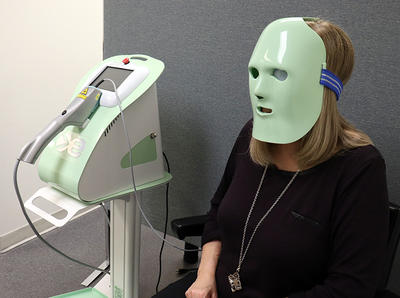The patient lies back in the chair with a pale green shield ̶̶ something like a goalie’s mask ̶̶ over her face. She rests comfortably as pulses of high-power LED light bathe the areas around her eyes.
These light pulses are stimulating the oil-producing Meibomian glands lining her eyelids, prompting them to boost production and slow down the evaporation of her tears.
This technology is called Eye-Light. It’s part of a suite of advanced tools now available in a new WOVS clinic focused on treating dry eye disease. The clinic (scheduled to open in May) will be one of the only locations in Canada with such a wide range of equipment. And that mean more treatment options for patients.

WOVS’ new Dry Eye clinic features an Eye-Light unit that uses high-power LED light to stimulate the Meibomian glands.
Giving dry eye disease the attention it deserves
Dry eye disease is one of the most common conditions optometrists see, affecting up to one-third of people over the age of 50. It’s associated with aging and, as the Canadian population grows older, it’s expected that the number of dry eye cases will continue to rise.
Dr. C. Lisa Prokopich is a WOVS professor and an expert in dry eye disease. She was the lead author of the national dry eye disease guidelines for Canadian optometrists. And since 2008, she has served as vice-president of the Sjögren’s Society of Canada.
Dr. Prokopich notes that dry eye disease doesn’t always get the attention it deserves, despite its impact on patients’ quality of life.
While we’ve been treating dry eye for many, many years in our Ocular Health Clinic, this new technology will allow us to assist people in ways that we couldn’t before.
-Dr. C. Lisa Prokopich
“Many of the patients we see are post-menopausal women who may have a number of conditions,” she says. “Their dry eye symptoms are sometimes attributed to post-menopause and may not be managed the way they deserve to be managed.”
“We’re excited about dry eye disease management because we can help these patients with things that have bothered them for a long time, but that they’ve shelved because they weren’t able to get help.”
“And while we’ve been treating dry eye for many, many years in our Ocular Health Clinic, this new technology will allow us to assist people in ways that we couldn’t before.”
Gathering data from the ocular surface
The new clinic will use ANTARES, a corneal topographer, to assess patients. ANTARES uses photography and algorithms to provide precise data from the ocular surface.
“ANTARES measures different components of dry eye disease, including levels of keratitis and tear break-up time,” Dr. Stanberry says. “We can use this data to stage dry eye disease more accurately and then suggest appropriate treatment. We’ll also be able to more easily track the results over time.”
On the treatment side, a number of devices will allow clinicians to tailor care to individual patients’ needs. Eye-Light uses intense pulsed light and low light therapy to stimulate the oil-producing glands along the lid line, reducing tear break-up in patients suffering from evaporative dry eye.
For those with Meibomian Gland Dysfunction (MGD), there’s new technology that clears the entrances to the oil-secreting glands. For instance, the BlephEx device runs a medical grade micro-sponge along the edges of the eyelids to remove debris, a procedure that, until now, clinicians performed manually with a debridement tool.
“In the past, we recommended patients use a Bruder mask to apply moist heat to the eyelids and that’s still a good choice for use at home. But we find these new tools allow the glands to function better and for longer periods of time,” Dr. Stanberry notes.
Helping to boost visual function
Although these new units are an exciting addition to the clinic, Dr. Prokopich emphasizes that they’re just a few of the tools available to clinicians.
“They won’t replace traditional treatments like anti-inflammatory therapy, compounding pharmaceuticals and scleral lenses. But in some cases, they might be a really good option for helping patients get relief.”
However, it’s important to remember that dry eye isn’t just about symptoms; it’s a visual disease that can have a devastating impact.
“Our patients struggle at their jobs, they struggle at home. They struggle with devices – the cell phones, computers and TVs that are such a big part of our day-to-day life. They’re hampered by their inability to see and the fluctuations in their vision,” she says.
“We’re not just helping them feel more comfortable. We’re helping them function better visually.”






